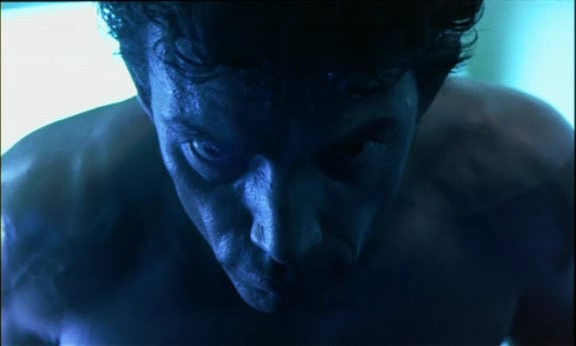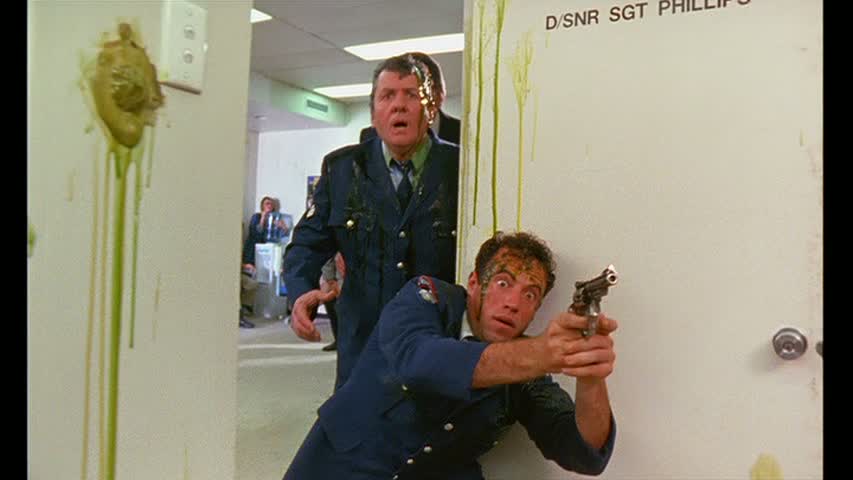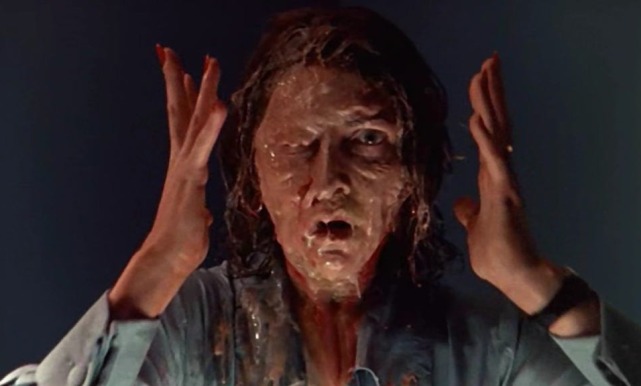Body Melt will be screening as a part of Psychoplasmic Panic! Cronenberg and the Rise of Body Horror at the TIFF Bell Lightbox theater on Sunday, November 17th, 2013 at 7:15pm.
In the early nineties, video store shelves were inundated with an influx of splatter-comedies, and for every Evil Dead 2 or Bad Taste there seemed to be two or three no-budget knockoffs with only half of the style and wit of those that came before them. In 1993, Philip Brophy and Rod Bishop (of the Australian art-rock band → ↑ →) threw the Ozploitation flick Body Melt into the splat-stick ring – a kinetic and satirical genre entry that adds a hefty dose of body horror to the proceedings. Though not without its faults, Body Melt comes out swinging, and certainly lands more hits than misses.
The film opens at the Vimuville Corporation, a natural health conglomerate readying a new type of vitamin (V52) for some human test subjects (four distinct households located on a cul-de-sac in Melbourne). One rogue Vimuville scientist has decided to warn these participants of their impending doom, but he has already been infected with a deadly amount of what appears to be the glowing green goo from Re-animator. En route to his spectacular death, he dictates the symptoms he is experiencing: “The first phase is hallucinogenic, the second phase is glandular”. He never gets around to the third phase, but the film’s poster rightly reminds us that Body Melt is in fact, the third phase.
From here, the film sprouts into multiple narrative branches, one for each of the four subjects located in Pebbles Court, Homesville. One house is delivered powdered vitamin supplements, a pregnant woman receives doses straight from a Vimuville doctor, another family is provided with an infomercial on VHS for a spa getaway package, and a pair of teens are lured to the Vimuville laboratory with the promise of sex in return for sperm donations.
Thematically, the film doesn’t get too caught up in driving home the skewering of Melbourne’s fitness-obsessed culture of the early nineties – but regardless the film toys with that idea behind all of the splatter. When the two teenagers wind up stranded on an outback farm with a trio of incestuous, cannibalistic characters – one of whom is later revealed to be ex-Vimuville – one teen quips: “I guess this is that clean country air we all hear about”. “Everything in the country ain’t always that fresh” the seemingly deformed leader replies. Take a stroll through any modern supermarket and you’ll be bombarded with country fresh, idyllic forest-like imagery and claims of 100% natural ingredients used on products that would never be classified as healthy – as if anything and everything from nature is automatically great for human consumption.
While awaiting a flight out of Melbourne, the divorced father character who has received supplement packets begins his first phase of hallucinations – one of which is a vision of some punk-rockers sitting across from him. They take one look at this overly health-obsessed and clearly perturbed individual and scoff “See? Too many drugs!”. Even the party heavy, try-anything generation doesn’t seem to be willing to toy with their bodies to this extent – hallucination or not.
Elsewhere, the family decides to partake in a weekend long excursion to Vimuville’s all-inclusive spa – at the suggestion of their VHS infomercial, of course. Whilst there, they’re fed remarkable new food-stuffs packed with nutrients and experimental vitamins designed to nourish the body through comfort food. The film goes as far to have one character ask “Wow, why hasn’t anyone thought of this before?” in bewilderment. Michael Pollan‘s book In Defense of Food speaks plenty about “edible foodlike substances” that contain nutrients long-separated from their point of origin – and how this could in turn dilute their potential health benefits. Body Melt takes this idea to the extreme, by making the vitamin infused food not only detrimental, but destructive. One could argue that Philip Brophy and Rod Bishop were just dreaming up new ways to infect the characters in their film, but here we are in 2013 where Dempster’s is marketing a line of “Garden Vegetable” enriched sliced bread. Really?
And what’s the result of all this tampering? Why, Cronenberg-ian body freak-outs, of course! Yes, humanity’s insatiable drive to better their bodies in Body Melt leads to scenes where these bodies can take no more – turning on their owners in a parade of cheek-inflating, enormous-tongue wagging terror.
A glance at the credits reveals that the film’s screenplay is actually based on a series of short stories, which lends to the splintered-yet-related feel to the story – but results in some incoherence as well. The four-pronged script also serves to function as commentary on the marketing of new drugs. Each subject has been selected for a totally customized delivery service, from the aforementioned infomercials, doctor approved injections and straight up illegal field testing. This might ring as an exaggerated example of the lengths that a comically shady pharmaceutical corporation will go to when dealing with these kinds of drugs, but for anyone with Dallas Buyers Club fresh in their mind, the reality that health and safety isn’t always priority number one when marketing drugs will feel scarily relevant – especially since the film was written and produced in 1993.
Aside from these headier moments, the script mostly consists of a series increasingly gruesome death scenes – which range from exploding penises, a runaway fetus, hallucinations of rib-extractions, all the way to full on face melting and chest bursting. Philip Brophy has clearly learned a thing or two at from Jackson and Raimi, as the grue is surrounded by hyper-stylized, over-excited camera work and pulsating electronic music to keep the energy level high. The two teenagers in the outback subplot does seriously threaten to tear that energy down though, as much of it seems unnecessary. While there’s some demented laughs to be found in this stretch, it could have been expedited fairly easily while still containing the plot points Body Melt needed to hit in these scenes. Even at a scant 81 minutes, this stuff makes the film feel as though it’s dragging on.
Regardless, Body Melt succeeds at the very least as a gore delivery service – dishing up seriously whacked out scenes of carnage throughout. The fact that there’s some cleverly subtle satire under the hood is an added bonus. Because come on, any film that features both a critical eye on the pharmaceutical industry, and two characters addicted to adrenal glands extracted from dead Kangaroos is at least worth a watch, right?




November 14, 2013
No Comments
By Dan Gorman